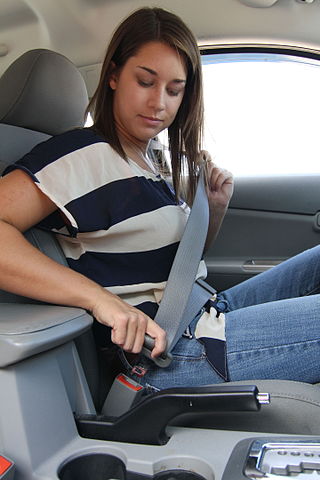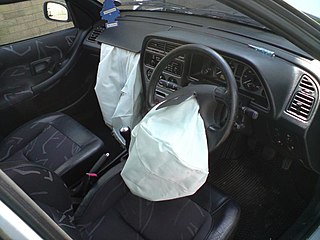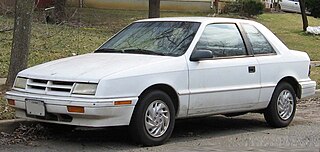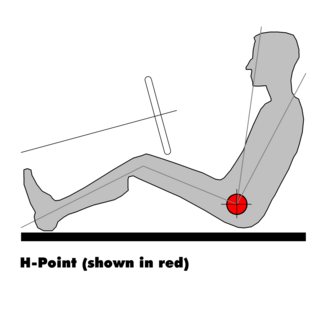
A seat belt is a vehicle safety device designed to secure the driver or a passenger of a vehicle against harmful movement that may result during a collision or a sudden stop. A seat belt reduces the likelihood of death or serious injury in a traffic collision by reducing the force of secondary impacts with interior strike hazards, by keeping occupants positioned correctly for maximum effectiveness of the airbag, and by preventing occupants being ejected from the vehicle in a crash or if the vehicle rolls over.

An airbag is a vehicle occupant-restraint system using a bag designed to inflate extremely quickly, then quickly deflate during a collision. It consists of the airbag cushion, a flexible fabric bag, an inflation module, and an impact sensor. The purpose of the airbag is to provide a vehicle occupant with soft cushioning and restraint during a collision. It can reduce injuries between the flailing occupant and the interior of the vehicle.

Unsafe at Any Speed: The Designed-In Dangers of the American Automobile is a non-fiction book by consumer advocate Ralph Nader, first published in 1965. Its central theme is that car manufacturers resisted the introduction of safety features, and that they were generally reluctant to spend money on improving safety. This work contains substantial references and material from industry insiders. It was a best seller in non-fiction in 1966.

Automotive safety is the study and practice of design, construction, equipment and regulation to minimize the occurrence and consequences of traffic collisions involving motor vehicles. Road traffic safety more broadly includes roadway design.

The Dodge Shadow and Plymouth Sundance are economical 3-door and 5-door hatchbacks that were introduced for the 1987 model year by the Chrysler Corporation. For 1991, a 2-door convertible variant was added to the Shadow lineup; this bodystyle was not offered by Plymouth. The Sundance/Shadow replaced the Omni/Horizon models of their respective marque.

A car seat is the seat used in automobiles. Most car seats are made from inexpensive but durable material in order to withstand prolonged use. The most common material is polyester.
The National Highway Traffic Safety Administration is an agency of the U.S. federal government, part of the Department of Transportation. It describes its mission as "Save lives, prevent injuries, reduce vehicle-related crashes" related to transportation safety in the United States.

The National Traffic and Motor Vehicle Safety Act was enacted in the United States in 1966 to empower the federal government to set and administer new safety standards for motor vehicles and road traffic safety. The Act was the first mandatory federal safety standards for motor vehicles. The Act created the National Highway Safety Bureau. The Act was one of a number of initiatives by the government in response to increasing number of cars and associated fatalities and injuries on the road following a period when the number of people killed on the road had increased 6-fold and the number of vehicles was up 11-fold since 1925. The reduction of the rate of death attributable to motor-vehicle crashes in the United States represents the successful public health response to a great technologic advance of the 20th century—the motorization of America.

A child safety seat, sometimes called an infant safety seat, child restraint system, child seat, baby seat, car seat, or a booster seat, is a seat designed specifically to protect children from injury or death during vehicle collisions. Most commonly these seats are purchased and installed by car owners, but car manufacturers may integrate them directly into their vehicle's design and generally are required to provide anchors and ensure seat belt compatibility. Many jurisdictions require children defined by age, weight, and/or height to use a government-approved child safety seat when riding in a vehicle. Child safety seats provide passive restraints and must be properly used to be effective. However, research indicates that many child safety restraints are often not installed or used properly. To tackle this negative trend, health officials and child safety experts produce child safety videos to teach proper car seat installation to parents and caregivers.
An event data recorder (EDR), more specifically motor vehicle event data recorder (MVEDR), similar to an accident data recorder (ADR) sometimes referred to informally as an automotive black box, is a device installed in some automobiles to record information related to traffic collisions. In the USA EDRs must meet federal standards, as described within the U.S. Code of Federal Regulations.

Head restraints are an automotive safety feature, attached or integrated into the top of each seat to limit the rearward movement of the adult occupant's head, relative to the torso, in a collision — to prevent or mitigate whiplash or injury to the cervical vertebrae. Since their mandatory introduction in some countries beginning in the late 1960s, head restraints have prevented or mitigated thousands of serious injuries.

Most seat belt laws in the United States are left to the states and territories. However, the first seat belt law was a federal law, Title 49 of the United States Code, Chapter 301, Motor Safety Standard, which took effect on January 1, 1968, that required all vehicles to be fitted with seat belts in all designated seating positions. This law has since been modified to require three-point seat belts in outboard-seating positions, and finally three-point seat belts in all seating positions. Seat belt use was voluntary until New York became the first state to require vehicle occupants to wear seat belts, as of December 1, 1984. New Hampshire is the only state that has no enforceable laws requiring adults to wear seat belts in a vehicle.

The H-point is the theoretical, relative location of an occupant's hip: specifically the pivot point between the torso and upper leg portions of the body — as used in vehicle design, automotive design and vehicle regulation as well as other disciplines including chair and furniture design.

Miles Electric Vehicles was a manufacturer and distributor of all-electric vehicles manufactured by FAW Tianjin in China that met international car safety standards. Miles was given the "Electric Car Company of 2007" award by Good Clean Tech. The company filed for bankruptcy on June 11, 2013.
When a person makes a claim for personal injury damages that have resulted from the presence of a defective automobile or component of an automobile, that person asserts a product liability claim. That claim may be against the automobile's manufacturer, the manufacturer of a component part or system, or both, as well as potentially being raised against companies that distributed, sold or installed the part or system that is alleged to be defective.

Takata Corporation was a Japanese automotive parts company. The company had production facilities on four continents, with its European headquarters located in Germany. In 2013, a series of deaths and injuries associated with defective Takata airbag inflators made in their Mexico plant, led Takata to initially recall 3.6 million cars equipped with such airbags. Further fatalities caused by the airbags have led the National Highway Traffic Safety Administration (NHTSA) to order an ongoing, US-wide recall of more than 42 million cars, the largest automotive recall in U.S. history. In June 2017, Takata filed for bankruptcy. It was acquired by Key Safety Systems.
The BeSeatSmart Program is a federal grant-based program supported by the Governor's Highway Safety Program, Vermont, and hosted by The Vermont Department of Health. BeSeatSmart provides child passenger safety seats, hands on help, advice, consultations, presentations, training, materials and support to residents of Vermont. BeSeatSmart provides best practice advice as given and sourced by the American Academy of Pediatrics (AAP) and the National Highway Traffic Safety Administration (NHTSA).
Williamson v. Mazda Motor of America, Inc., 562 U.S. 323 (2011), was a decision by the Supreme Court of the United States, in which the Court unanimously held that Federal Motor Vehicle Safety Standard 208, promulgated by the National Highway Traffic Safety Administration, does not federally preempt state tort lawsuits against auto manufacturers from injuries caused by a defective lack of certain types of seat belts.

A New Car Assessment Program is a government car safety program tasked with evaluating new automobile designs for performance against various safety threats.
Federal Motor Vehicle Safety Standard 208 regulates automotive occupant crash protection in the United States. Like all other Federal Motor Vehicle Safety Standards, FMVSS 208 is administered by the United States Department of Transportation's National Highway Traffic Safety Administration.















